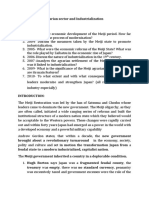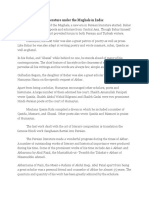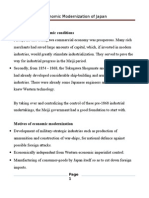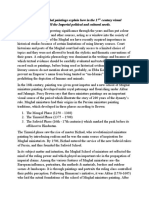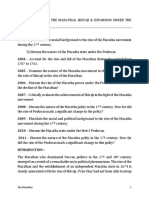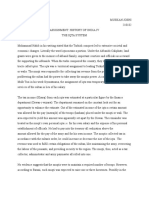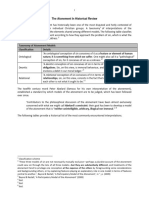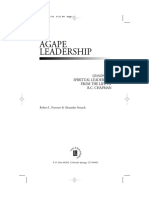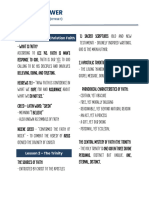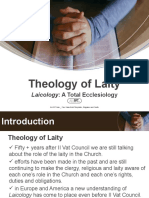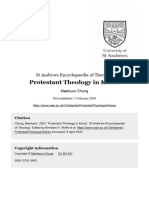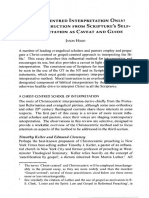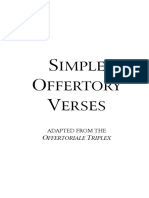Rise of the Modern West Assignment
By - Dias Mario Antony, B.A History (hons.)-II
Critically discuss the causes of the English Revolution and the various
interpretations given by historians on it.
In this essay I have tried to put forward the causes of the English revolution
by first giving a narrative of the period which led up to the revolution and
then following it up with the interpretations given by various historians on
the issue.
The term English Revolution is generally used to describe the period of the
English Civil Wars and the commonwealth, where the parliament challenged
King Charles I’s authority and engaged in military conflict with the royalists.
This was followed by a period of bourgeoisie rule for the next ten years up to
1660 when monarchy was restored and Charles II was given the throne. But
the years from 1640-1660 cannot be seen as the only period of the revolution,
however it is true that the period was the defining years of the revolution, a
revolution which had been growing in England for almost a whole century and
it was at this time that it finally exploded.
There were many causes which ultimately led to the revolution and some of
them were long term causes which had been around for almost a century. In
dealing with the causes of the English revolution, Lawrence Stone has
conveniently divided them into three broad categories. The first being the
long term preconditions which had prevailed in England for the last century,
the second was the medium term precipitants and finally the short term
triggers which made a probable revolution an inevitable one.
With the reformation that had happened in the previous century, the crown
had broken away from Rome and seized monastic properties. This had two
main impacts - the first that the crown was now more dependent on the
parliament mainly for financial aid, and the other was that a lot of land was
now made available in the market.
�Meanwhile the various wars that had been fought by England had drained its
coffers and to meet its financial requirements, the crown sold the lands that it
had seized to newly upcoming classes. Monopoly over certain resources like
coal and the sale of titles were some of the other methods used to procure
finances. The early Tudor monarchs had built up the authority of the gentry in
the countryside over landed magnates of the medieval times. These classes as
time passed acquired more wealth and land and became very powerful and
eventually wanted more share in legislation and executive of the country.
Another cause was extreme religious oscillations that had been there during
the reigns of Edward VI and Mary and this deepened the confusion in the
minds of the people and also developed national hatred of Catholicism. This
was the reason why the people were constantly suspicious of Charles I and his
marriage to the Roman Catholic French princess Henrietta Maria.
Furthermore, the crown could not maintain adequate control over the written
and spoken word and these were the main instruments used by the
opposition in later times to spread their ideas. A lack of essential troops also
weakened the position of the crown as it had to depend on hired mercenaries
who were very expensive.
There was an economic growth in the years before the civil war mainly due to
the doubling of the population which forced them to expand cultivation,
improve techniques and increase trading activities. The economic
developments of the period dissolved the old bonds and maximization of the
profits came to be the main agenda. There was also an enormous increase in
the population of the landed and professional classes. Land was becoming a
highly attractive field for investment and those with the capital acquired it.
For example, the gentry were acquiring lands from both ends in the sense that
it received land from the crown and from the small landholders who were
being squeezed due to the constant price rise in the 16th century and resultant
inflation and so were forced to sell their lands. The decline of the aristocratic
classes saw the rise of the gentry and professional classes such as lawyers,
doctors and merchants. This change occurred mainly due to the concession
provided by the crown to these classes and also because of the extravagant
lifestyles that were maintained by the aristocracy.
�One of the main reasons that had led to the revolution was the erosion of the
trust of the people in the main organs of the government. The 16 th and the 17th
centuries saw the loss of prestige and respect of such bodies among the public.
As mentioned above, there was a decline in the aristocracy who began to sell
titles in order to maintain their lifestyles. The courts also suffered a decline as
it became a marketplace for the disposal of cash and granting favors. The
bureaucracy had become corrupt as a result of the crown cutting down their
pay when it incurred financial losses. A major example of this can be seen in
the Duke of Buckingham who put up everything for sale in the 1620’s from
bishopric to judgeship to nobility titles. The personal failings of the monarchs
like James I of whom people were always suspicious of his foreign policies and
his close association with the Spanish Ambassador further deteriorated the
respect that the crown had commanded from the people.
The decades before the revolution saw a spread of new ideas especially that of
Puritanism among the lower middle classes. Puritanism provided a basis and
justification for challenging the existing orders. The different competing
religions created doubts in the minds of the people and eroded the religious
authority. It shattered the unquestioning and habitual faith of the past. Hobbs
describes this as a period boiling hot with questions. One of the main reasons
for the spread of new ideas was the increase in the numbers of those receiving
education. A class of intellectuals thus arose as the universities were turning
out more educated people that the available jobs.
The ideology of the country was also an important factor as it was presented
as the exact opposite of the court. The country was seen as an ideal,
environmentally superior, peaceful and clean whereas the court was just the
opposite being corrupt and filthy. There was discontent among many due to
the huge social mobility, both geographically and vertically, mainly from the
1540’s to the time of the revolution.
Moving on to the precipitants which were the causes just a few decades before
the revolution Christopher Hill says that the Tudor monarchy was backed by
the politically effective classes because they benefitted from it. On the other
hand the Stuart monarchs with their pro-foreign policies were disliked by the
�people and lost the support of those who had been in favor of the Tudors.
Another reason was that the crown refused to respond positively to criticisms.
The support which the crown showed for the Arminian church also became a
serious issue of clash. The puritans were opposed to it and they held opposite
views on predestination and clashed over forms of worship. With William
Laud being appointed as archbishop, the crown totally supported Lauds goals
to restore the power and prestige of the bishops and to bring back old forms
of worship. Those who opposed Laudian reforms were persecuted and many
fled the country. The people were suspicious of Laud’s reforms as it could lead
to the restoration of Catholicism. Such policies caused an increase in the
numbers of puritan supporters as the Anglican laity and the gentry were now
forced into the opposition camp.
With Charles dissolving the parliament in 1629, it marked the beginning of the
eleven years of tyranny. The crown was now forced to raise money in an
arbitrary manner which lost its support of different groups. Tunnage and
Poundage continued to be collected without parliamentary approval and the
Ship Money was also imposed, a tax which was initially imposed on the
merchants living in the port towns and then to those living inland. It had not
been used for a long time and so when it was imposed, a lot of merchants
joined with the opposition. Also the gentry were now fined for their failure to
take up knighthood.
There was also an economic reaction when the guild organization was
imposed from above by the crown to maintain control over the different
industrial and artisan classes. These merchants were supporters of the crown
and were now annoyed with the constant interference. So when the crown
turned to them for help, they refused causing the downfall of the regime. The
crown committed a major blunder when it brought up Strafford and Laud as
now all the hatred and the grievances of the nation was now focused on these
two.
The short term triggers were the causes that gave the final push to the
revolution. A trigger was pulled when Charles and Laud attempted to impose
on the Scottish clergy the English system of worship and organization with the
�introduction of the ‘Common Book of Prayer’. This led to a full scale war with
the defeat of England and the crown losing control over its military. This was
followed by the Irish rebellion in 1641. The king granting permission to the
parliament to hold nationwide fasts on the last Wednesday of every month
until the end of the war with Ireland was a big blunder. The parliament chose
the preachers who were to speak in these meetings and so managed to spread
their ideas and influence over a large number of people.
The king drove the final nail into his coffin as he planned a coup with 400
soldiers on 4th January, 1642. His visit to Scotland in the vain hope of buying
their support resulted in him being now seen as a traitor and the civil war
began in full swing. It culminated in 1649 with the defeat and execution of
Charles I.
Historians over the years have found the causes of the English revolution
highly complex and inconclusive. From the simple interpretation that it was
rebellion against unpopular kings as suggested by Clarendron, the debate has
taken several complex turns since then.
The first major historian to write on the issue was S.R Gardiner from the
Victorian period. In his work the History of England 1603-1656 he explains it
as a Puritan revolution. This view has however drawn a lot of criticism from
the Marxist writers. E.J Hobsbawm and Maurice Dobb, has seen it as
revolution which was responsible for bringing down the feudal structure in
England and replacing it with a capitalist structure. They called it a bourgeois
revolution. According to them as the present restrictive production system
hampered the growth of the emerging social classes, a class-war was
inevitable and it took the form of English Revolution.
With the fall of the twentieth century writing on the subject has become more
complex with historians like R.H Tawney, Trever-Roper, Lawrence Stone and
Christopher Hill giving us various interpretations of the English Revolution.
According to R.H Tawney, the rising gentry, because of the redistribution of
land a century before the civil war and the decaying older landowners,
because of the inefficient management of land led to an upset in the balance of
property. He regards the civil war as an instrument to accommodate the
�power of these new gentry in the political system of the time. Lawrence
Stone who shares a somewhat similar view however elaborates on it by
adding the argument that the decline of the traditional landowners was
primarily due to their over-expenditure and not inefficient land management
as suggested by Tawney. Stone also stresses on how the aristocracy lost its
military powers, its territorial positions and their prestige. Their real income
had declined drastically and this left the crown and the church isolated.
H.R Trever-Roper however contends by putting forward the interpretation
that there was no substantial rise of the gentry but in fact they suffered a
massive decline due to the inflation in the 16th century. He puts forward that it
was the yeomen who moved up the ladder. He further elaborates his
argument by saying that it was the mere gentry or the rural gentry and small
and middling farmers who had interests different from those attached to the
court and these were the people who tried to overthrow the court system in
the 1640’s and emerged as the radical leaders of the New Model Army.
Christopher Hill however objects to the inclusion of lawyers by Trever-Roper
in the list of those who were attached to the court. He cites evidence to prove
that the larger sections of the lawyers had actually supported the parliament.
Hill traces the origins of the English revolution to the social and economic
consequences of the period of Henry VIII. He puts forward that the wealth and
the economic power which the church lost as a consequence of the
reformation was shifted to the hands of the crown. Hill thus argues that there
was no major land transfers during the reformation era as most of the wealth
remained within the landed ruling class and the politically influential people
at the time of dissolution of monasteries. However within the court of Henry
VIII there were lesser gentries who were gaining sympathy from the crown
compared to the older aristocracy who were losing the favor. Thus there was
a shift of power within the ruling landed classes. The newly acquired wealth
failed to strengthen the monarchy as most of it was soon dissipated from
spending on the construction of naval fleet and war with France.
The Social revolution according to Hill was taking place independently related
to the expansion of trade, manufacturing activities and changes in agriculture.
�Towards the close of the 16th century, while the gentry and the yeomen
strengthened their economic position by following capitalist means, the
aristocrats were again facing economic problems and appealed to the crown
for help which in turn conferred them with court offices and gave them rights
of industrial and commercial monopolies. This came as a blow to the
bourgeoisie and the gentry who saw their interests being threatened and
brought the rival groups into open conflict with each other. For Hill it was a
‘bourgeois revolution’ as far as English Revolution was concerned. Hill
however in his later works; he suggests that the new political, social and
intellectual concepts of the so called middling-class comprising merchants,
artisans and yeomen motivated them towards radical experiments between
1640 and 1660. He calls it the ‘Puritan Revolution’, the term Puritanism
however was not used by him in a strictly religious sense. The major
limitation of Hill’s work is that he fails to provide reasons for why the feudal
landlords did not mend their households to cope up to the economic
pressures in spite of sufficient opportunities to benefit from the existent
economic conditions.
J.H. Hexter around the same time came out with a vigorous attack on both
Tawney and Trever-Roper Thesis. He accused them of trying to fit the events
of the 17th Century England into the pre-determined mould of Marxist theory
while ignoring the ideals and ideology of the period. He saw politics as merely
a struggle of the ‘Ins’ versus the ‘Outs’, the court versus the country. However
Hexter’s own explanation of the social changes prior to 1640 was a new
version of Lawrence Stone’s Thesis. He declined Stone’s idea of the financial
decay of the old aristocracy but argued that there had been a collapse of the
military control by the aristocracy over the greater gentry. This meant that the
political leadership had shifted from the House of Lords to the House of
Commons, though the immediate causes of the political breakdown of the
1640’s was ascribed by him to the traditional religious and constitutional
factors.
There are also several other historians like P. Zagorin who have written
extensively on the origins of the English revolution. He created a model which
showed the English Revolution as a result of the attempt on part of the under-
�privileged and over-taxed ‘country’ against the expanding, oppressive, corrupt
and authoritarian courts and bureaucracies of the age. But the larger question
is whether England at the time processed such a large bureaucracy and court
which could inflict such an influence.
As we have seen there are numerous causes which have been suggested for
the beginning of the English revolution by various historians. The debate can
however be broadly divided into the Whig historians who have given a
political narrative of the revolution, the Marxist historians who have given
us a socio-economic interpretation of the English Revolution, Revisionist
Historians who have challenged the idea that the Civil War was inevitable
because of ideological or class struggle. They emphasize the role of short-term
factors, such as Charles’ personality and the divisive effects of his religious
policies and the more recent Post-Revisionist historians who also challenge
the idea that the Civil War was inevitable. They often focus on the English Civil
War as part of a larger British perspective stressing the importance of events
in Scotland and Ireland. Some also admit that long-term causes before the
reign of Charles I may have an important place in provoking conflict. The
vastness and complexity of the society, polity and economics during the
period has left Historians perplexed and the debate continuing.
Bibliography
1. Stone, Lawrence, The causes of the English Revolution 1529-1642,
Routledge and Kegan Paul, London.
2. Hill, Christopher, the English Revolution 1640, Lawrence and Wishart Ltd,
London.
3. Hill, Christopher, edt. Geoff Eley and William Hunt, Reviving the English
Revolution, Reflections and Elaborations on the Work of Christopher Hill,
Verso, London.
4. Sinha, Arvind, Europe in Transistion, From Feudalism to Industrialization,
Manohar, Delhi, 2014.
















